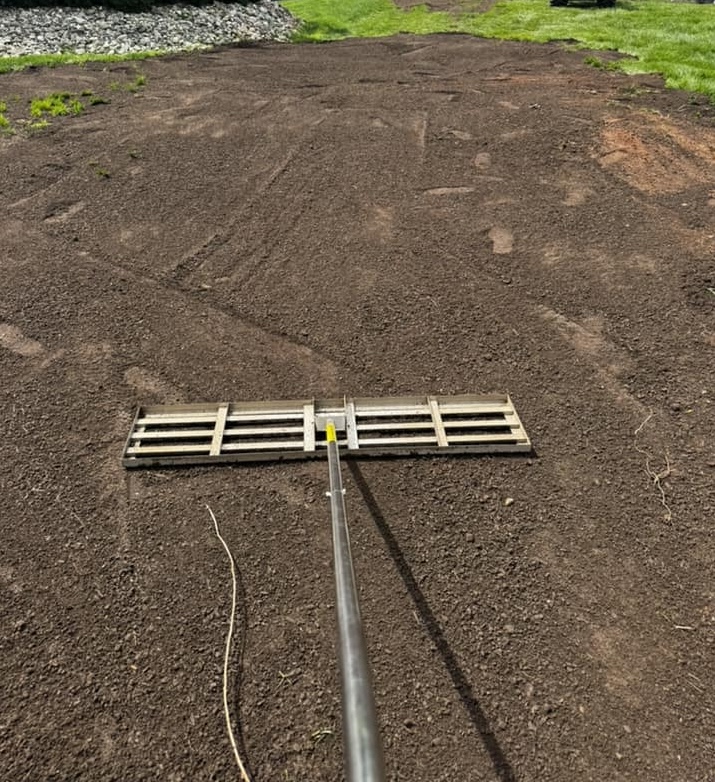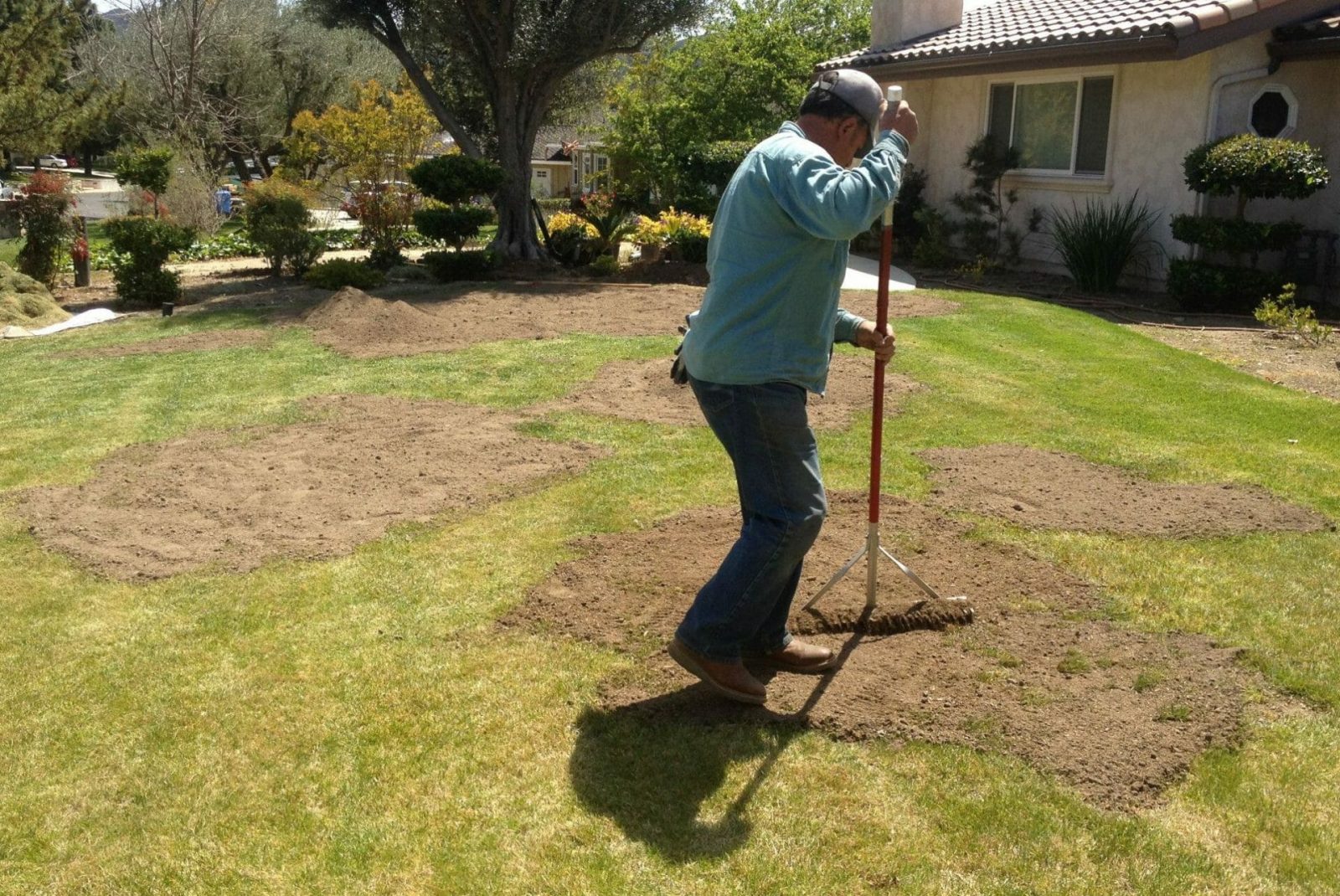Aesthetically, a bumpy yard is not attractive, but that’s not all; it can also cause falls and trips. Furthermore, improper grading can cause home basement and foundation issues.
Therefore, you may want to learn how to level a yard by hand for your property’s and your sake.
Leveling your yard gives your outdoor landscape stability and helps you avoid severe foundation damage and costly repairs.
While hiring someone to level your yard is an option, you can do it yourself, especially if it is only a tiny portion of your lawn and the unleveled part is below 2 feet.
There are different ways of leveling a yard, and we’ll discuss them below.
What Is Yard Leveling?
Yard leveling refers to the process of reshaping the ground surface in a yard or outdoor space to create a level and even surface.
This process involves removing excess soil, filling in low areas with additional soil, and smoothing out the surface to create a uniform grade.
Yard leveling is commonly performed to correct uneven ground that can cause water drainage problems, prevent proper installation of landscaping features, or make it difficult to walk or use the outdoor space.
Also read:
The process can be done manually with hand tools or with heavy equipment like bulldozers and graders, depending on the size and scope of the project.
Why Level A Yard?
Regardless of why your yard is unlevel, you must address this issue because enjoying your lawn with bumps and lumps isn’t problematic. Also, it can cause other serious problems like water pooling.
Level your yard for the following reasons:
1. Improve Drainage
The low spots on an unlevel yard can cause water pooling and drainage problems. Water pooling causes various issues like mold growth, dead grass, excessive mosquito infestation, and perpetual mud. Leveling your lawn ensures rainwater flows successfully, thus preventing standing water.
2. Better Aesthetics
An aesthetically appealing lawn gives you an excellent reason to do things outdoors, whether playing or relaxing. A level yard looks neat, tidy, and well-maintained. Also, it can boost your home’s curb appeal and render it more inviting.
3. Enhanced Safety
Uneven ground can pose a tripping hazard, particularly for young children and elderly individuals. Leveling the yard can make it safer to walk or play in.
4. Gardening and Landscaping
The vegetation, flowers, and ground cover in your lawn will suffer if the lawn is uneven. For instance, unpredictable or irregular water drainage leads to puddling, hurting the plants. Also, the vegetation may suffer from erosion, making some areas poor for plant growth.
In addition, your lawn must be level to install landscaping features such as a patio or pool
5. It Makes Lawn Care Easier
Mowing an uneven lawn is difficult since piloting your lawnmower over such a yard leads to cutting the grass unevenly. In addition, it can lead to scalping or uneven cutting. On the other hand, a level yard is attractive, easier to maintain, and ensures your grass grows evenly.
6. Prevent Water Damage
Different structures can suffer water damage if it pools near them. For instance, standing water can corrode structures, cause mold and wood rot, and flood your basement.
Can You Level A Yard Yourself?
Yes, you can carry out a DIY project to level your yard if you have experience and the proper tools. However, keep in mind that it can be a challenging and time-consuming task, especially when dealing with a sizeable area or significant grade changes.
Consider hiring a professional landscaper if you are dealing with an over 2 feet drop. You can level your yard by hand with rakes and shovels or heavy machineries such as a backhoe or bulldozer.
How to Level a Yard: Step-By-Step

If you’re looking to level up your yard, here are some steps you can follow:
Step 1. Assess Your Yard
Take a look at your yard and identify any areas that are uneven or have dips and bumps. This will help you determine where you need to focus your leveling efforts.
Step 2. Gather Your Materials
You’ll need a few tools to level your yard, including a shovel, a rake, a wheelbarrow, and a tamper. You may also need additional soil, sand, or gravel to fill in any low spots.
Step 3. Remove Debris
Remove any rocks, branches, or other debris from the area to be leveled. This will help you get a clear view of the ground and avoid any damage to your tools.
Step 4. Mow and Dethatch Your Lawn
Cut your grasses short but not too short to the extent of exposing their stems since that may kill them. After that, identify and remove thatch buildup, if any using a thatch rake or a lawn dethatcher.
Step 5. Identify The Problem Areas
Walk around your yard, then use a long level or a string line to identify the unleveled areas.
Step 6. Remove the Grass in The Low Spots
Dig up the grass on your lawn’s low spots by digging 2 to 3 inches under the soil using a shovel to ensure you get the whole root.
Step 7. Remove High Spots
Check for high spots in your yard, then remove them using a shovel or a pickaxe. Start at the area’s edges, then work your way inward. Keep the excavation depth to a minimum, as you will need to fill these areas later.
Step 8. Fill In Low Spots
Bring soil to the low spots using a wheelbarrow to fill in the low spots, then use a rake to spread it out evenly and a hand tamper to compact it. Keep adding soil and compacting until the area is level with the entire ground.
Step 9. Recheck The Level
Once you fill the low spots, check whether the ground is level using a level or string line. Make any necessary adjustments to the soil until it is level.
Step 10. Install edging
Install edging material like landscape timbers or bricks to hold the soil in place and prevent erosion. Make sure the edging is level with the surrounding ground.
Also read: Cheap Lawn Edging Ideas
Step 11. Add Grass Seed
You can either put back the sod you removed earlier or plant grass seeds. If you choose seeds, pick the type you already have on your lawn for uniformity. In addition, use the instructions provided on the seed bag to ensure you apply the correct rate.
Step 12. Water The Area
Water will help encourage grass growth and for the soil to settle, so apply a generous amount but not too much.
Step 13. Apply Topdressing If Necessary
After a couple of watering sessions, check for standing water or water runoff. Applying topdressing is necessary if your lawn is still not level.
Final Remarks
With the right tools, plan, and know-how, leveling your yard is a relatively straightforward project. In fact, it can be a fun, fulfilling task to do over the weekend. Remember that ongoing maintenance is essential once you level your lawn.

Hey there, I’m Derek Schew, a writer for Lawnholic.com, where we cover everything and anything related to lawns. As someone who’s spent countless hours tending to my own lawn, I’m passionate about sharing my knowledge and helping others achieve the perfect yard. From lawn care tips to product reviews, I’m committed to providing our readers with the most accurate and up-to-date information available. So whether you’re a seasoned lawn enthusiast or just getting started, I invite you to join our community and discover the joys of a lush, green lawn.


What is this tool called that I seen to smooth out the dirt to even out my yard?
Hi Jan,
It’s a garden/ dirt rake. You can find it here Garden Rake on Amazon.